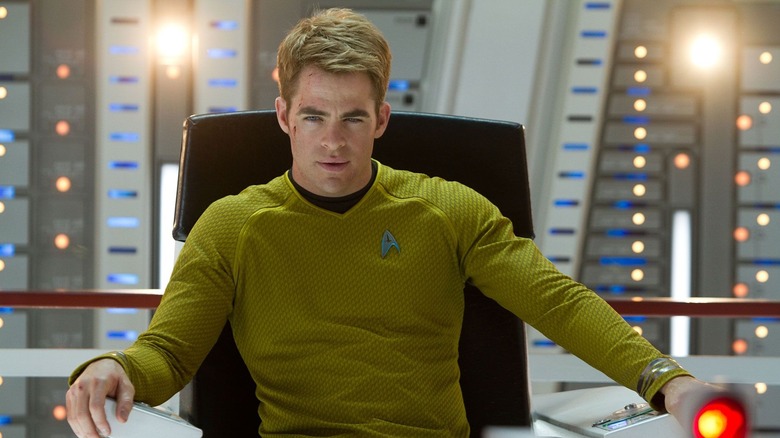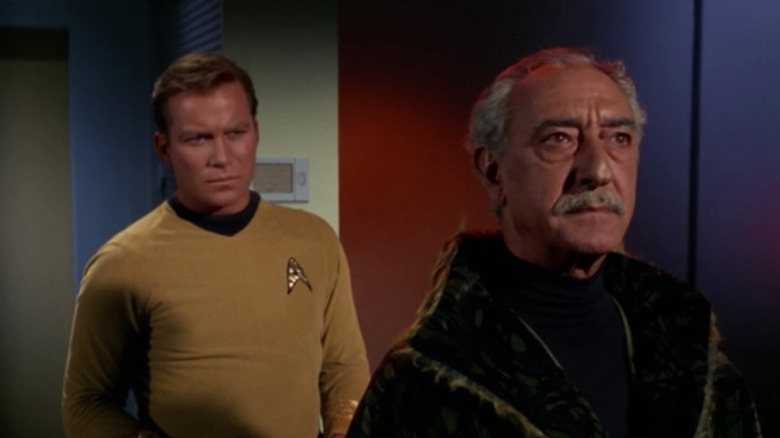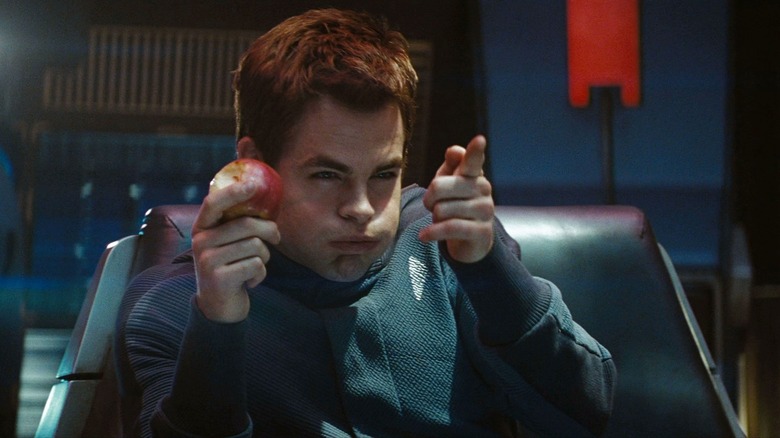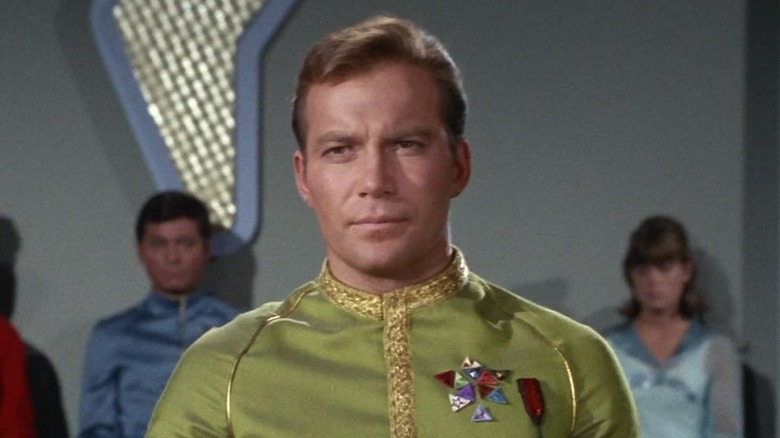The Real (Nerdy) Reason Why Chris Pine's Captain Kirk Is So Different From William Shatner's
When J.J. Abrams' feature film "Star Trek" was released in theaters in 2009, there seemed to be a clear creative mandate at work. "Star Trek" was set prior to the events of the 1966 TV series on which it was based, telling an alternate timeline version of how the well-known "Trek" characters all first met. Kirk (Chris Pine), Spock (Zachary Quinto), and the rest of the crew were all depicted as younger, hotter versions of themselves, each one more youthful and impulsive than their adult counterparts from 1966.
Given the hot-headedness of the Enterprise crew and the entire 2009 film's "action-packed" vibe, the mandate mentioned above seems to have demanded the filmmakers kick everything into OVERDRIVE. It's as if they wanted critics to respond with the phrase, "This ain't your grandpa's 'Star Trek.'"
It's worth noting that the writers of "Star Trek" — Roberto Orci and Alex Kurtzman — were basing their characters not on how they appeared in "Star Trek," but on a general, unfamiliar pop culture interpretation of them. Kirk, to cite the most obvious example of this, was depicted as a young, horny, arrogant ladies' man who winks at danger and is generally rude and reckless. The "reckless cowboy" image of Capt. Kirk (William Shatner) perhaps originated from a mere handful of 1960s behavior examples, paired with a healthy comparison to the far more studious Capt. Picard on "Star Trek: The Next Generation." In observation, Kirk was in fact a much more reasoned, restrained character than the pop image of him might have non-Trekkies believe. And yet, the cowboy was what a mass audience knew, so that's what the 2009 filmmakers went with.
The real reason for Kirk's behavioral change, however, may be something far nerdier that can fit handily into "Trek" canon.
Kodos the Executioner
Yes, delving into the fineries of "Star Trek" canon is one of the dweebiest intellectual activities imaginable. But activating that particular neural gland gives Trekkies no small amount of pleasure, and good-natured nitpicking is one of our most edifying joys, so delve we shall, fellow nerds. Spreading headcanon amongst ourselves is the thing that brings us together. Indeed, credit goes to William Bibbiani for initially making this post's central observation.
Trekkies may recall the original series episode, "The Conscience of the King" (December 8, 1966). In that episode, the Enterprise is called to a distant planet to investigate the identity of a local actor named Anton Karidian (Arnold Moss). Karidian is appearing in a local production of "Macbeth," and has spent the last few decades building his profile as a performer of classics. An old friend of Kirk's (William Sargent), however, strongly believes that Karidian is, in fact, Kodos the Executioner, a murderous monster who somehow escaped apprehension decades before and who changed his identity.
Years before, Kodos was the mayor of a distant Federation colony that was rapidly running out of food. The starships with supplies were so far behind, the colonists began to starve. Rather than let the colony waste away, Kodos elected to murder half the population. As it so happens, Kirk was present for the massacre of Tarsus IV. Kirk had moved away from Earth, only to witness the deaths of 4,000 people. By Trek's timeline, he was only 13 or 14 years old.
In "Conscience," Kirk has to investigate Karidian to see if he is actually Kodos and also stem the rash of rage from other officers who also witnessed the killing.
Surely, witnessing a massacre would change a child.
Trauma versus no trauma
Indeed, if Kirk has witnessed a massacre as a teen, having escaped being murdered himself, he would likely be a soberer, more wounded figure. He likely spent many years in counseling. It may also be what drew him to an organization like Starfleet, a peacekeeping outfit that is devoted to structure and exploration. Kirk was willing to engage in military tactics if the situation called for it (see: "Balance of Terror"), but he rarely went in with guns blazing and clearly had no taste for killing or for military conquest.
The 2009 version of Kirk, meanwhile, was brash, lascivious, and rebellious. According to the timeline of the 2009 film, a vengeful Romulan named Nero (Eric Bana) traveled back in time to 2233, on the day of James Kirk's birth. He attacked the U.S.S. Kelvin, which was being piloted by Kirk's father George (Chris Hemsworth). In killing Kirk's father, the timeline shifted, and the entire "Star Trek" universe changed. In the parallel universe, a fatherless Kirk became an unsupervised brat, stealing vintage cars and listening to vintage music. His life of rebellion led others to encourage him to enlist in Starfleet (not apply for Starfleet Academy, weirdly), sensing that he is destined for great things. He never left Earth to live on Tarsus IV, and never witnessed a massacre.
As such, this new version of Kirk wouldn't be marked by that trauma. He would, instead, experience a very general sense of 20-year-old ennui.
(Curiously, Nero's time travel shenanigans also somehow changed where starships are built. In "Trek" lore, Starfleet vessels are constructed at the Utopia Planitia Feet Yards orbiting Mars. For some reason, in the Kelvin timeline, they're constructed on Earth only a few miles from Kirk's home).
The new Kirk
When the new Kirk became a Starfleet captain, it was without the sobering experience of youthful trauma, and without years of counseling. Shatner's Kirk was not immature nor rash. He did often rely on his masculine wiles to escape desperate situations, and did occasionally rip apart entire civilizations because they were, say, run by the malevolent computer Landru, but for the most part he was practical. Spock (Leonard Nimoy) was too logical to lead, and Dr. McCoy (DeForest Kelley) was too passionate. He was the balance between the two.
Conventional wisdom may dictate that the Enterprise crew as they appeared in the 2009 film were driven by their youthful energy and uncontrolled, immature impulses. This, I think, is only part of the story for Kirk. He's not just young in the 2009 film, but an entirely different character. When young Kirk cheats on the unpassable Kobayashi Maru test at Starfleet, he doesn't even pretend that he's being tested. Instead, he eats an apple and flippantly walks out of the room when he passes. Shatner's Kirk may have also cheated at the Kobayashi Maru, but surely he would not have been so brash about it. When it comes to growing up, Chris Pine's Kirk had a longer way to go.
Also, the Kelvin-verse eventually saw the destruction of both the Romulan homeworld (in Nero's future timeline) and the destruction of the Vulcan homeworld (in the past). The Kelvin-verse "Star Trek" movies took place in an era of enhanced military preparation and constant violence. Pine's Kirk, then, would never be allowed to grow into a calm-minded, diplomatic leader. He would, rather, become a tactician, a winking military general, willing to take action.
That is quite far from where Shatner's Kirk would end up.



